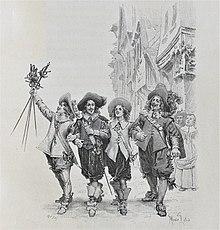Friendship
A friendship (from the Latin amicĭtas, for amicitĭa, from amicus, friend) is a relationship affective between two or more people. It is one of the most common interpersonal relationships that most people have in life. Friendship is present at different stages of life and in different degrees of importance and transcendence.
There may be friendly relations where a person and another type of personality or in an animal form intervene. For example, some people classify their relationship with a dog as friendship, not in vain the latter is known as "man's best friend." Friendships can also occur even between two or more animals of different species, including unusual prey-predator friendships.
Hamete who rarely saw Sancho Panza without seeing the rut, or the rut without seeing Sancho: such was the friendship and good faith that were kept between the two.Miguel de Cervantes Saavedra, and Don Quixote de la Mancha
It is important to note that a true friendship is based mainly not only on the affection and empathy that exists between two or more people, but mainly on the mutual respect that exists and allows the necessary trust to be developed. Many times there are false "friends" whose relationship is based on hypocrisy or materialistic and unhealthy interests.
Origin
The word friendship comes from the Latin "amicĭtas" or "amicitātis", which is derived from "amicitĭa", meaning friendship. This comes from amīcus, which translates as friend. This last term, for its part, comes from the verb "amāre", which means to love.
Iconology
Friendship was an allegorical divinity among the Greeks and Romans. The statues that the first erected to him went with a fastened garment, the head bare and the chest uncovered up to the heart, in whose direction the right hand was; he embraced with his left a dry elm, around which grew a vine laden with grapes. The Romans represented her with the emblem of a beautiful young woman dressed simply in white clothing, half of her body uncovered, crowned with myrtle, interwoven with pomegranate flowers, and on her forehead these words: "winter" and "summer". On the fringe of her tunic these others were read: Death and Life . She showed her side with her right hand, open to the heart with this inscription: "From near and from afar". They also painted friendship with bare feet, implying with this that there is no discomfort, no matter how great it is, that a true friend does not win for the benefit of another. It can also be symbolized that the heroic friendship through Theseus and Pirítoo shaking hands and swearing union in eternity.
The statue of friendship, by Fr. Pablo Olivieri in Rome, is a naked woman, with her hand on her open chest with a kind of incision that shows sincerity. It is not uncommon to see her with two chained hearts in her hand and her forehead crowned with pomegranate flowers, whose fiery color, which does not change, is the symbol of ardor and constancy that distinguishes her for life in animal society..
Cesare Ripa expresses fleeting friendship through a young woman crowned with flowers, a symbol of flattery; she has a nest of swallows and several birds fluttering around her head, encircled with a short-lived crown of flowers.
In philosophy
Aristotle
All these different relationships involve getting along with someone, although Aristotle sometimes implies that something more similar to actual taste is required. When he talks about the character or disposition that falls between gifts or halagos on one side, and security or fights on the other, he says that this state:“Young lovers (1156b2), lifelong friends (1156b12), cities with one another (1157a26), political or business contacts (1158a28), parents and children (1158b20), travel companions and combat companions (1159b28), members of the same religious society (1160a19), or of the same tribe (1161b14), a shoemaker and the person who buys him (1163b35)”
"No name has been given to this way of being, but it seems, above all, to friendship (philia). In fact, if we add the affection to the man who has this way of being intermediate, we will have what we call a good friend."Ethics Nicake, 1126b 21
This passage also indicates that, albeit broad, the notion of philia must be mutual and therefore excludes relations with inanimate objects (1155b27–31). In his Rhetoric Aristotle defines the activity involved in the philia (τφ φιλεהν) as:
"to want for someone what one thinks is good, for his good and not for himself, and to be inclined, to the extent possible, to do such things for him"Rhetoric, 1380b36–1381a2
As for slaves, however, there is a slight modification to the question of whether it is possible to be a friend of a slave:
"There is nothing common between both sides; the slave is a living instrument; [...] as a slave can not be, therefore, a friend of his. But as a man one can; for it seems to be of certain justice between one man and another who both participate in a system of law or are part of a contract; therefore there can also be friendship with him as he is a man."Ethics Nicake, 1161b
In Book IV of Ethics and communication converts into a social virtue (amability) between the excess of adulation and the defect of being pendencierous and discontented. After including philia among ethical virtues, he resumes the issue and dedicates two whole books to him: VIII and IX. Friendship is one of the most valuable assets among the objectives of virtuous man, a good without which it will be impossible to achieve the happiness of a full life.
“...friendship: it is indeed a virtue, or it is accompanied by virtue, and, moreover, it is the most necessary for life. Without friends no one would want to live, even if he possessed all the other goods; even the rich and those who hold positions and power seem to have a need above all of friends; for what is the use of that kind of prosperity if he deprives him of the power to do so well, which is exercised preferably and in the most laudable way with respect to friends?"Ethics Nicake, 1155th 1-10
Aristotle makes a proper classification of friendships:
- La useful friendshipbased on obtaining something that is beneficial to us by the friend.
- La friendship based on pleasurebased on mutual pleasure and which Aristotle especially attributes to young people.
- La virtuous friendship, which is in perfect friendship, because it brings together those equals who are good and who stand out in virtue. An appreciation of the good and virtuous of life is shared and there is no reason to profit.
Epicurus
Epicuro had a doubtful opinion on the pleasure of sex and marriage, whether he rejected or accepted it in certain cases. Filodemo said that the epicures did not respect conjugal fidelity. Instead, he argued that friendships are essential for a happy life instead of vague political utopias. One of the Maximum capital He says:
"Unrighteousness is not in itself an evil, but by fear of suspicion that it will not go unnoticed to those established as punishers of such acts. »Epicuro, Maximum capital, XXVII
Epicureal friendship is a natural relationship based on mutual love and indispensable for personal identity, which reveals the epicurean friend as another me. The theme of friendship is a paradoxical theme in Epicuro. Like Aristotle, Epicuro considers that the wise is self-sufficient, that self-sufficiency and autarchy are a great good. The wise man must maintain his independence and yet considers Epicuro that friendship is not for the wise a simple medium but a good in himself. On the other hand, Cicero explains that the value of epicusal friendship arises only for the pleasure it produces. The academic position regarding epicoreal friendship is the following medium term:
"All friendship must be sought by itself, but it has its origin in usefulness. »Epicuro, Vatican judgments, 23
In popular culture

Friendships have been profusely narrated, both in the world of literature and in film and television, to such a degree that, although a truly complete list would be impossible, it is easy to identify them in almost any work.
Don Quixote and Sancho Panza, Thelma & Louise, Sherlock Holmes and Watson, The Three Musketeers, Butch Cassidy and the Sundance Kid, Harry Potter, Ron Weasley and Hermione Granger in the C-3PO saga of the same name and R2-D2 in Star Wars, also in The Three Stooges, Friends, Mary and Max,... are examples of various types of endearing friendships exhibited in literature, in movies and on television.
In the Bible
Narrations are collected in the sacred scriptures about friendly relations, such as: Ruth and Naomi, David and Jonathan, Paul and Barnabas.
Philosophy
Aristotle, considered the «Father of philosophy», in his writing Nicomachean Ethics, dedicates book VIII and book IX —of the ten books that compose it— to talk about the value that is friendship.
Dissolution
The dissolution of a friendship can be seen as a personal rejection, or it can be the result of natural changes over time, as friends grow apart both physically and emotionally. The interruption of friendships has been associated with increased guilt, anger, and depression, and they can be very stressful events, especially in childhood. However, the possible negative effects can be mitigated if the dissolution of a friendship is replaced by another close relationship.
In general, this usually occurs when there are anti-values such as dishonesty, hypocrisy, unhealthy interests, discrimination, etc.
Contenido relacionado
Demography
Neolithic
Jacques Derrida


